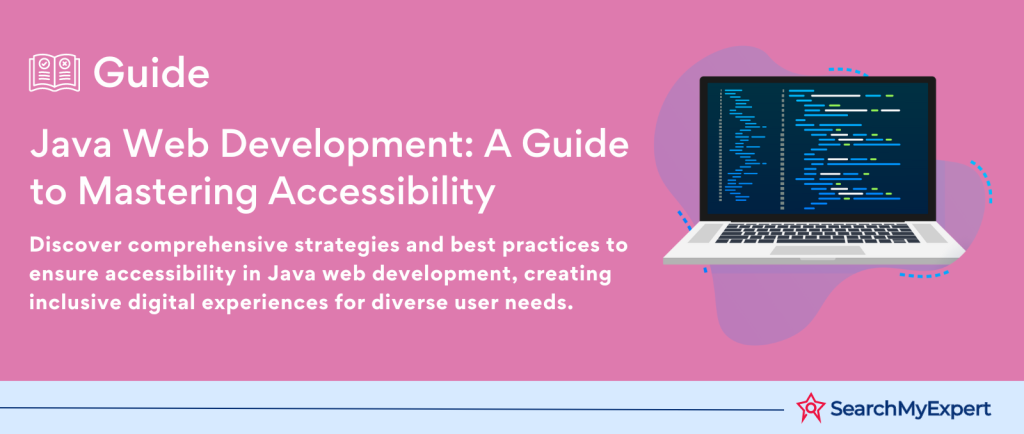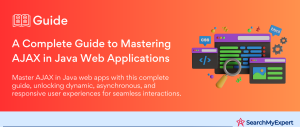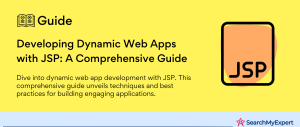Java Web Development Accessibility Practices
Web Accessibility: A Gateway to Universal Usability
Web accessibility is about ensuring the digital world is navigable, understandable, and usable for everyone, regardless of disabilities or impairments. It’s like building a bridge across the digital divide, connecting users with different abilities to a world of information and interaction.
Why Accessibility in Java Web Development?
Java, a powerhouse in the world of programming, drives numerous web applications. Incorporating accessibility into Java web development isn’t just a nod to inclusivity; it’s a commitment to reaching a broader audience. Imagine Java as the foundation of a building. When accessibility is integrated, it ensures that every room, hallway, and space is accessible to everyone, regardless of their physical or cognitive abilities.
The Benefits: Beyond Compliance
Building accessible web applications is not just about adhering to legal standards. It’s about creating a better user experience for all. Here’s how:
- Extended Reach:
Accessible web apps invite a wider audience, including the 1 billion people worldwide with disabilities. - Improved User Experience: Accessibility principles often enhance the overall usability for all users, not just those with disabilities.
- Legal Compliance: It keeps your web application on the right side of laws like the Americans with Disabilities Act (ADA).
- SEO Benefits:
Accessible websites are often more search engine friendly, improving your site’s visibility and ranking. - Brand Image:
Committing to accessibility reflects positively on your brand, showcasing social responsibility and inclusivity.
Web accessibility in Java development isn’t just a feature; it’s a cornerstone of modern, user-centric web design. By embracing these practices, developers can create more inclusive, effective, and successful web applications that stand the test of time and technology.
Understanding WCAG Guidelines
WCAG: The Compass of Web Accessibility
The Web Content Accessibility Guidelines (WCAG) are the North Star for digital accessibility. Developed by the World Wide Web Consortium (W3C), WCAG provides a comprehensive set of recommendations to make web content more accessible to people with disabilities. Think of WCAG as a roadmap, guiding developers through the complex terrain of accessibility.
The Four Pillars of WCAG
WCAG stands on four key principles, each a cornerstone in building an accessible digital world:
Perceivability: Information and user interface components must be presented in ways that all users can perceive. It’s like ensuring everyone at a concert can hear the music, whether they’re in the front row or at the back.
- Examples:
Text alternatives for non-text content, captions for videos, content that can be presented in different ways.
Operability: User interface components and navigation must be operable by all users. Imagine a door that everyone can open, regardless of how they interact with it.
- Examples: Keyboard accessibility, enough time to read and use content, no content that causes seizures.
Understandability:
Information and operation of the user interface must be understandable. It’s about making sure that everyone can follow the story, not just those who know the language.
- Examples: Readable text content, predictable web pages, and input assistance for errors.
Robustness: Content must be robust enough to be reliably interpreted by a wide variety of user agents, including assistive technologies. This is like building a bridge that can withstand all weather.
- Examples:
Compatibility with current and future user tools, and proper use of standards.
WCAG Success Criteria and Levels
WCAG sets specific success criteria to meet these principles, categorized into three levels of conformance:
- Level A: The basic level. It’s like ensuring there’s a ramp for wheelchair access.
- Level AA:
Deals with the biggest and most common barriers for disabled users. This is like providing braille options alongside visual signs. - Level AAA: The highest and most stringent level. This is like having a sign language interpreter for every speech.
Each level builds on the previous one, creating a more accessible web environment at each step. It’s a journey from basic accessibility to an exceptional level of usability for all.
Understanding and implementing these guidelines is key in Java web development. It ensures that the applications we create are not just powerful and efficient, but also inclusive and accessible to all.
Building a Perceptible User Interface
Visual Accessibility: More than Meets the Eye
- Sufficient Contrast:
It’s vital to ensure that the text stands out against its background. High contrast makes reading easier, not just for those with visual impairments, but for everyone. Think of it as making your text pop off the page! - Color Blindness Considerations: Design with colorblind users in mind. Avoid color combinations that are hard to differentiate. Use patterns or labels to convey information, not just color. It’s like adding subtitles to a color-coded story.
- Image Descriptions and Alternatives:
Every image should tell a story, even to those who can’t see it. Use alt text to describe images, ensuring screen readers convey the message. It’s like translating a picture into words. - Non-Text Content Alternatives:
Not just for images, but for videos, charts, and audio too. Provide descriptions, transcripts, or other alternatives to ensure everyone gets the full picture.
Audibility: Ensuring Everyone Can Hear the Message
- Audio Transcripts: Offer transcripts for audio content. This isn’t just for those who are hard of hearing; it helps users who prefer reading to listening.
- Captioning:
Captions are crucial for videos. They ensure that deaf or hard-of-hearing users can follow along, and are also helpful in noisy or quiet environments. - Audio Controls: Give users control over audio elements. This means volume control, but also the ability to pause, stop, or replay audio.
- Keyboard Focus for Interactive Audio Elements: Ensure that users navigating with a keyboard can access all audio controls. It’s like providing a remote control for the web.
Mobile Accessibility: Reaching Users on the Go
- Responsive Design: Your site should look great and function well on any device. Responsive design ensures usability, no matter the screen size.
- Touch-Friendly Layout:
Make buttons and links easy to tap. Space them out to avoid accidental touches, and ensure they’re large enough to be tapped easily. - Zoom Compatibility:
Let users zoom in on your site without breaking the layout. This is crucial for users who need to enlarge text and images to see them clearly.
By focusing on these aspects, Java web developers can create interfaces that are not just usable, but genuinely accessible to a wider audience, ensuring that the digital world is inclusive for all.
Ensuring Keyboard and Screen Reader Operability
Keyboard Navigation: The Key to Accessibility
- Importance of Keyboard Navigation:
Keyboard navigation is essential for users who can’t use a mouse. It’s like creating a path through your website that can be walked with arrow keys. - Implementing Focusable Elements:
Every interactive element should be accessible via the keyboard. This includes links, buttons, forms, and custom widgets. They should be focusable and interactive with the keyboard alone. - Keyboard Shortcuts and Tab Order: Create intuitive keyboard shortcuts for common actions. Ensure a logical tab order, guiding users through your content in a way that makes sense. It’s like laying out a welcome mat, showing the way through your site.
Screen Reader Compatibility: A Voice for Your Content
- Semantic Markup: Use HTML elements according to their intended purpose. Properly tagged headings, lists, and buttons tell a screen reader how to interpret the page. It’s like giving your website a voice.
- ARIA Attributes:
Accessible Rich Internet Applications (ARIA) attributes provide additional context to assistive technologies. They describe roles, states, and properties of UI elements. It’s like adding subtitles to a silent movie. - Clear Element Roles: Ensure every UI element has a clear role. A button should be marked as a button, a link as a link. This helps screen readers convey the purpose of each element to the user.
By focusing on these aspects, Java web developers can create web applications that are not only functional but also inclusive. Keyboard navigation and screen reader compatibility are crucial in ensuring that everyone, regardless of their abilities, can access and interact with your content.
Making Information Clearly Understandable
Crystal Clear Text Content
- Clarity is King:
Write text that’s easy to digest. Think of your words as a clear, well-lit path through a forest – simple, direct, and leading exactly where your users need to go. - Avoid Jargon:
Jargon and technical terms can be barriers. When they’re unavoidable, accompany them with simple explanations. It’s like translating a foreign language into a universal dialect.
Structured and Logical Navigation
- Proper Heading Structure:
Use headings like signposts. They should guide users through your content, clearly indicating what each section is about. It’s like having clear, well-marked signs on a highway. - Logical Navigation:
Organize your content so that it flows naturally. Users should be able to predict what comes next and how to get there. It’s about building a bridge from point A to point B.
Global Accessibility: Internationalization and Localization
- Internationalization:
Prepare your content for a global audience. This means designing your application in a way that makes localization possible. Think of it as creating a universal template that can be adapted for different cultures. - Localization:
Adapt your content for different regions and languages. This isn’t just about translating words; it’s about adjusting to cultural norms, symbols, and formats. It’s like tailoring a suit to fit the wearer perfectly.
By focusing on these aspects, Java web developers can create content that is not just accessible, but also easy to understand and navigate for a wide range of users, from different backgrounds and with different abilities.
Implementing Best Practices and Tools
Harnessing Libraries and Frameworks
- Accessibility Libraries for Java:
Dive into libraries specifically designed for enhancing accessibility. They’re like toolkits, equipped with ready-to-use components that adhere to accessibility standards. - Frameworks with Built-in Accessibility Features: Some frameworks come pre-loaded with accessibility features. They’re like starting a race with a head start, giving you a foundation that’s already compliant.
Automated Testing Tools: Your Digital Accessibility Consultants
- Automated Testing Tools: These tools are like detectives, scouring your web application to find and report accessibility issues. They help you identify problems that might be missed by manual testing.
- Continuous Integration: Incorporate these tools into your continuous integration pipeline. It’s like having a quality check at every stage of your development process, ensuring accessibility isn’t an afterthought.
Integrating Accessibility into the Development Workflow
- Accessibility from the Start:
Make accessibility a part of your initial design and development process. It’s easier to build it in from the beginning than to retrofit it later. - Regular Accessibility Audits: Conduct periodic reviews of your application for accessibility. Think of it as regular health check-ups for your web application.
- Team Education and Awareness: Foster a culture of accessibility within your team. It’s not just the responsibility of a few; it’s a collective goal.
By incorporating these practices and tools, Java web developers can create web applications that are not only functionally robust but also universally accessible, ensuring that the digital world is inclusive and open to all.
Key Takeaways: Building a World Accessible to All
- Accessibility is Essential: It’s not just a feature – it’s a fundamental aspect of modern web development. Building accessible Java web applications means opening doors for everyone.
- Follow WCAG Guidelines: These are your roadmap to accessibility. They provide clear, actionable steps to ensure your web applications are accessible to all.
- Use the Right Tools: Leverage libraries, frameworks, and testing tools. They’re the nuts and bolts that hold the structure of accessible web development together.
- Integrate Accessibility into Your Workflow:
Make it a standard practice, not an afterthought. It’s about weaving accessibility into the fabric of your development process. - Continuous Learning and Improvement:
Accessibility is an evolving field. Stay informed, stay engaged, and always look for ways to improve.
Resources for Further Learning
- WCAG Documents: Web Content Accessibility Guidelines (WCAG) 2.1
- Accessibility Tools: Explore tools like Axe, WAVE, or Lighthouse for testing and improving web accessibility.
- Community Forums:
Engage in forums like Stack Overflow or web development groups on LinkedIn for insights and support.
Champion Accessibility for Inclusive Web Experiences
We encourage all developers to champion accessibility. It’s about building a web that’s inclusive, where diversity is not just acknowledged but celebrated. Your role as a developer extends beyond coding; it’s about crafting experiences that are accessible, enjoyable, and useful for everyone.
Conclusion
Accessibility in Java web development is imperative for creating inclusive digital experiences. Adhering to WCAG guidelines, utilizing accessibility-focused tools, and embedding these practices into the development lifecycle are crucial steps toward achieving this goal. As developers, we have the power and responsibility to craft web applications that cater to all users, regardless of their abilities. By championing accessibility, we not only comply with standards but also enrich the web ecosystem, making it a welcoming space for everyone. Let’s commit to building a more accessible and inclusive digital world.
Transform your business with leading Java Development Service Companies.
Table of Contents
Toggle






